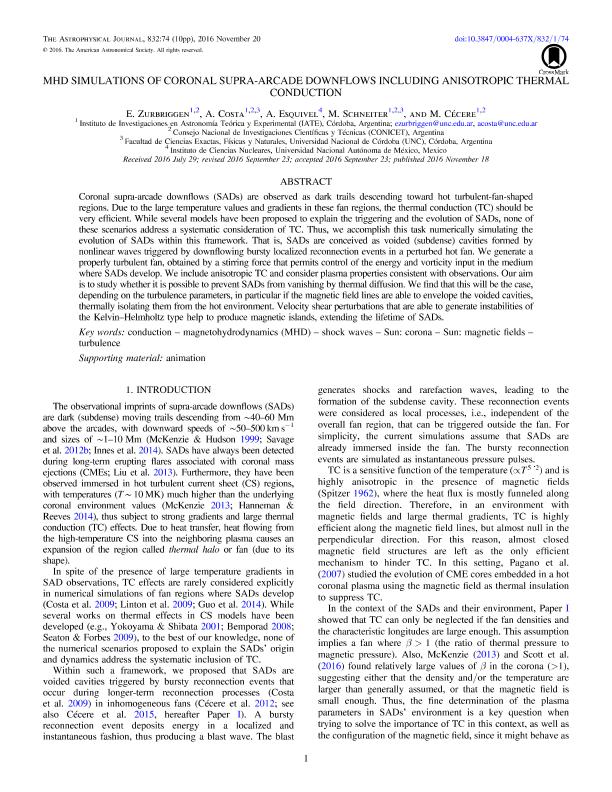Artículo
MHD simulations of coronal supra-arcade downflows including anisotropic thermal conduction
Zurbriggen, Ernesto ; Costa, Andrea
; Costa, Andrea ; Esquivel, A.; Schneiter, Ernesto Matías
; Esquivel, A.; Schneiter, Ernesto Matías ; Cécere, Mariana Andrea
; Cécere, Mariana Andrea
 ; Costa, Andrea
; Costa, Andrea ; Esquivel, A.; Schneiter, Ernesto Matías
; Esquivel, A.; Schneiter, Ernesto Matías ; Cécere, Mariana Andrea
; Cécere, Mariana Andrea
Fecha de publicación:
11/2016
Editorial:
IOP Publishing
Revista:
Astrophysical Journal
ISSN:
0004-637X
e-ISSN:
1538-4357
Idioma:
Inglés
Tipo de recurso:
Artículo publicado
Clasificación temática:
Resumen
Coronal supra-arcade downflows (SADs) are observed as dark trails descending toward hot turbulent-fan-shaped regions. Due to the large temperature values and gradients in these fan regions, the thermal conduction (TC) should be very efficient. While several models have been proposed to explain the triggering and the evolution of SADs, none of these scenarios address a systematic consideration of TC. Thus, we accomplish this task numerically simulating the evolution of SADs within this framework. That is, SADs are conceived as voided (subdense) cavities formed by nonlinear waves triggered by downflowing bursty localized reconnection events in a perturbed hot fan. We generate a properly turbulent fan, obtained by a stirring force that permits control of the energy and vorticity input in the medium where SADs develop. We include anisotropic TC and consider plasma properties consistent with observations. Our aim is to study whether it is possible to prevent SADs from vanishing by thermal diffusion. We find that this will be the case, depending on the turbulence parameters, in particular if the magnetic field lines are able to envelope the voided cavities, thermally isolating them from the hot environment. Velocity shear perturbations that are able to generate instabilities of the Kelvin-Helmholtz type help to produce magnetic islands, extending the lifetime of SADs.
Archivos asociados
Licencia
Identificadores
Colecciones
Articulos(IATE)
Articulos de INST.DE ASTRONOMIA TEORICA Y EXPERIMENTAL
Articulos de INST.DE ASTRONOMIA TEORICA Y EXPERIMENTAL
Citación
Zurbriggen, Ernesto; Costa, Andrea; Esquivel, A.; Schneiter, Ernesto Matías; Cécere, Mariana Andrea; MHD simulations of coronal supra-arcade downflows including anisotropic thermal conduction; IOP Publishing; Astrophysical Journal; 832; 1; 11-2016
Compartir



